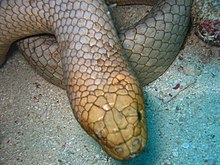Aipysurus laevis
| Aipysurus laevis | |
|---|---|
 |
|
| Scientific classification | |
| Kingdom: | Animalia |
| Phylum: | Chordata |
| Class: | Reptilia |
| Order: | Squamata |
| Suborder: | Serpentes |
| Family: | Elapidae |
| Genus: | Aipysurus |
| Species: | A. laevis |
| Binomial name | |
|
Aipysurus laevis Lacépède, 1804 |
|
Aipysurus laevis is a species of venomous sea snake found in the Indo-Pacific. Its common names include golden sea snake,olive sea snake, and olive-brown sea snake.
The olive sea snake swims using a paddle-like tail. It has brownish and purple scales along the top of its body whilst its underside is a white color. It can grow up to a meter in length, and in some cases up to two meters. While it can be aggressive towards prey, attacks on divers or larger animals are usually rare, though if provoked it will engage the attacker. The snake's main predators are sharks and ospreys.
It is a common, widespread species that lives on coral reefs, including the Great Barrier Reef. It can also be found in the eastern Indian Ocean and the western Pacific Ocean. The creature hides in small coves or protective coral areas if not hunting or surfacing to breathe. It feeds on crustaceans, fish, and fish eggs. It uses venom to incapacitate its prey. This snake in particular has venom that contains enzymes which break down the prey from within for easier digestion. The venom also affects both the muscles and nerves of the prey. The snake usually hunts in coral reef areas, searching for food via poking their head through crevices. The creature usually stays away from open water as a hunting ground.
Aipysurus laevis has been found to have photoreceptors in the skin of its tail, allowing it to detect light and presumably ensuring it is completely hidden, including its tail, inside coral holes during the day. While other species have not been tested, A. laevis possibly is not unique among sea snakes in this respect. Dermal light sensitivity is found in all the major animal phyla.
Males can reach sexual maturity in their third year, while females do not until their fourth or fifth year. Courtship usually involves a group of males vying for one female, which occurs in open water. Fertilization is internal and lasts for about nine months. Females can give birth up to five young at a time. In rare cases there can be ten or eleven young at once. Life expectancy of the snake is about fifteen years, sometimes a bit longer.
While there are not many threats to the Aipysurus laevis, man-made dangers do exist for it. Prawn trawls are one of the greatest threats for the creature, up to 50% of olive sea snakes caught in trawls are killed, while the ones that survive usually suffer injuries. Death from prawn trawls often comes either from drowning or being crushed.
Currently, two subspecies are recognized, including the nominotypical subspecies described here.
...
Wikipedia

